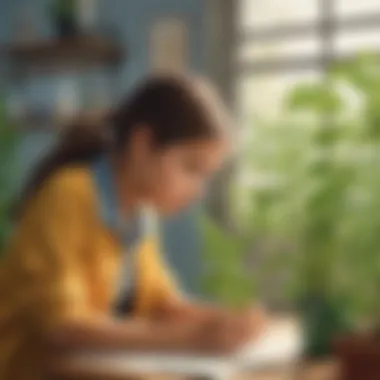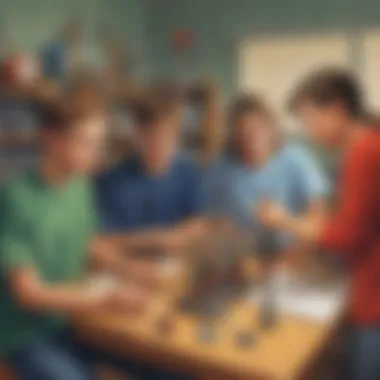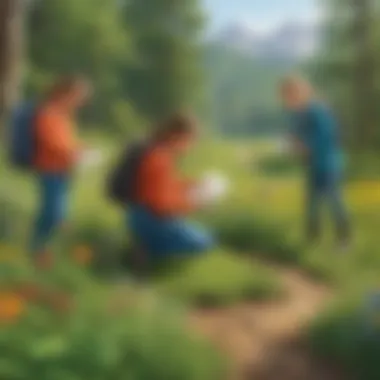Engaging Science Activities to Inspire Fifth Graders


Intro
In a world where education evolves rapidly, fostering curiosity and critical thinking in students is vital. Specifically, for fifth graders, engaging in science activities can bridge theoretical concepts with practical understanding. This article provides a comprehensive guide on a range of science activities tailored for children at this crucial stage of academic development. By leveraging interactive learning methods, educators can create a dynamic environment that encourages students to explore and learn in an enjoyable way.
Interactive Learning Games
The role of interactive games in learning is transformative. These games often blend knowledge acquisition and play, making them an effective tool for fifth graders.
Popular Games
Some of the most notable educational games include:
- DragonBox: This math-based game offers challenges that teach algebra concepts through puzzles.
- Science Journal: An app that allows children to document and analyze their science experiments.
- Kahoot!: A quiz-based system that makes learning competitive and fun.
Description of top educational games
Each of these games caters to different preferences and subjects. For instance, DragonBox simplifies algebraic ideas, while Science Journal encourages practical scientific exploration. Kahoot! focuses on retention through repetition and fun competition.
Benefits of playing educational games for kids' cognitive development
Engaging with educational games provides children with several benefits, including:
- Improved problem-solving skills.
- Enhanced retention of information.
- A better understanding of complex concepts through interactive learning modes.
Game Reviews
Analyzing these games can help parents and educators make informed choices. Learning games that exceed expectations often share these traits:
- User-friendly interface.
- Diverse range of questions or problems.
- Adaptability to different learning speeds.
In-depth reviews of selected educational games
For instance, DragonBox has received acclaim for modernizing algebra education, allowing students to engage without the traditional frustrations of math learning. The approach focuses on concept rather than rote memorization, encouraging deeper understanding.
Comparison of gameplay and learning outcomes
In comparing the gameplay of DragonBox and Kahoot!, one observes distinct learning outcomes. DragonBox facilitates self-paced learning, while Kahoot! fosters real-time instructor-student interaction. Each game offers considerations in terms of setting conducive learning environments, leveraging the strengths of both game styles to enhance educational outcomes.
Creative DIY Projects
Hands-on science projects ignite creativity and innovation within children. Engaging in DIY activities pivots them from passive consumption of knowledge to active creation.
Step-by-Step Guides
Here's an example of a simple DIY project: Making a homemade volcano. Materials needed include:
- Baking soda.
- Vinegar.
- Food coloring.
- A small container (like a plastic bottle).
Instructions:
- Place the small container inside a tray to catch any overflow.
- Fill the container with baking soda.
- In a separate bowl, mix vinegar and food coloring.
- Pour the vinegar mixture into the baking soda and watch it fizz.
Benefits of hands-on activities for children's cognitive and motor skills
Completing hands-on science experiments builds problem-solving skills and hand-eye coordination. The process also instills resilience as children encounter unexpected outcomes and learn to adapt.
Craft Ideas
For an artistic twist, create magnets from bottle caps. This simple project requires items commonly found at home and can turn into a learning experience regarding magnetism and design.
By compiling creative craft ideas like this, parents can create a rich tapestry of learning experiences that develop children’s artistic expression., supporting their overall educational growth.
Engaging fifth graders in these forms of learning inspires them to ask questions, think critically, and develop a joy for science.
Preamble to Science Activities for Fifth Graders
Engaging science activities play a vital role in the education of fifth graders. At this age, children are curious and eager to understand the world around them. Incorporating science activities in their learning experiences can ignite this curiosity, guiding them into deep exploration and critical thinking. These activities not only align with educational standards but also provide an interactive platform for students to acquire essential skills.
Fifth graders benefit from hands-on learning. When engaging in experiments or projects, they move beyond passive learning. They actively participate, enhancing their understanding of scientific concepts. Through science activities, they develop critical skills such as observation, inquiry, and problem-solving. These activities also encourage teamwork. Students often work in groups, which helps them learn communication and collaboration. Such experiences are essential as they prepare for future academic pursuits and social scenarios.
In designing engaging science activities, educators must consider the interests and abilities of fifth graders. It is critical to choose age-appropriate materials and tasks. Preparation leads to an effective learning environment, allowing students to explore freely while managing potential risks.
“Active engagement in the learning process fosters an enchanting environment for young minds.”
Moreover, diversity in activities is essential. Each child has unique preferences. Some may enjoyhands-on tasks like experiments, while others might prefer creative projects. Therefore, offering a variety of science activities is better for maximizing participation and encouraging enthusiasm. Topics can cover the full spectrum of science, including biology, earth science, physics, and chemistry.
Finally, a focus on the real-world applications of science can further inspire students. Understanding the relevance of science is fundamental for sustaining their interest. When children see their learning reflected in everyday innovations, they become passionate about the sciences. As we explore specific science activities in the sections ahead, it becomes clear that time spent engaging with science is not just education—it is an investment in the thoughtful, analytical thinkers of tomorrow.
Importance of Engaging Science Learning
Engaging science learning is a crucial component in developing a well-rounded educational experience for fifth graders. When students connect emotionally and intellectually with the subject matter, they actively participate, which enhances their understanding and retention of concepts. The sustained interest exhibited during engaging activities encourages lifelong learning habits.
Benefits of Engaging Science Learning
- Enhanced Critical Thinking: Engaging activities challenge students to analyze, evaluate, and synthesize information. They develop problem-solving abilities, which are invaluable in today’s complex world.
- Increased Curiosity: An engaging learning environment sparks curiosity. When children are interested in what they are learning, they are more inclined to ask questions and seek answers, thus deepening their understanding of scientific concepts.
- Collaboration and Teamwork: Many science activities require students to work in groups, fostering teamwork and collaboration. These inter-personal skills are essential for thriving in both academic and real-world scenarios.
- Practical Application: Engaging science learning brings theory into practice. Activities can demonstrate how scientific principles apply to everyday life, solidifying their relevance and practicality beyond the classroom.
- Confidence Building: Successfully completing a challenging science activity instills a sense of accomplishment. When students see the results of their efforts, confidence in their abilities grows.
However, it’s essential to consider that just implementing activities is not enough. Genuine engagement requires a thoughtful approach from educators. Teachers should:
- Connect science concepts to students’ lives to make learning relevant.
- Scaffold activities appropriately to match various skill levels.
- Encourage exploration and inquiry rather than prescribing what to do.
In summary, the significance of engaging science learning goes beyond mere fun. It cultivates essential skills, nurtures a questioning mindset, and prepares students for future academic endeavors and personal experiences. Even at a young age, realizing the importance of scientific inquiry impacts their learning journey significantly, leading them to think critically and creatively.
Engagement paves the way to a deeper understanding of science and its wonders.
By prioritizing engaging science activities, educators and caregivers can create an enthusiastic, active learning environment that inspires fifth graders today and motivates them to pursue science-related interests tomorrow.
Key Objectives of Science Activities
One significant objective is to encourage collaboration among peers. Working in groups helps students develop abilities such as communication and teamwork. This social interaction fosters an environment of knowledge-sharing, where learners can expose each other to different viewpoints and methods of problem-solving.
Additionally, science activities aim to integrate knowledge across various disciplines. For instance, a biology-related investigation might incorporate elements of mathematics when collecting and analyzing data. This cross-disciplinary approach can make learning more holistic and relevant.
Many science activities utilize real-world scenarios that resonate with fifth graders. For example, a project on environmental science may involve examining local ecosystems or conducting a survey on recycling habits. By linking the curriculum to their immediate surroundings, students gain a stronger sense of relevance and importance in their learning.


Student engagement during science activities also enhances motivation and retention of information. When lesson plans are adaptable and hands-on, students are more likely to remain engaged. This engagement is essential for maintaining interest in scientific concepts, as enthusiastic students are often better equipped to understand and remember what they learn.
In summary, the key objectives of science activities for fifth graders encompass promoting curiosity, fostering collaboration, integrating interdisciplinary learning, highlighting real-world connections, and enhancing student engagement. Each of these factors plays an important role in creating a robust learning environment.
All these aspects contribute to not just understanding science in theory, but also embracing it as an invaluable tool in daily life.
By keeping these objectives in mind, educators can create activities that are not only educational but also profoundly enjoyable.
Understanding the Scientific Method
Understanding the scientific method is critical for fifth graders engaging in science learning. This method serves as a roadmap for exploration, encouraging young learners to approach problems logically. It helps in developing analytical skills that are essential in not only science but any aspect of life. Engaging with the scientific method enhances reasoning and boosts confidence in drawing conclusions based on evidence.
Definition and Stages
The scientific method consists of several key stages, which can be broken down into the following:
- Observation: Noticing and describing phenomena or problems.
- Question: Formulating a question based on observations.
- Hypothesis: Proposing an answer or explanation that can be tested.
- Experiment: Conducting experiments to test the hypothesis.
- Analysis: Reviewing data gathered during experiments to draw conclusions.
- Conclusion: Summarizing findings and assessing whether the initial hypothesis was supported or refuted.
- Communication: Sharing results with others.
Each stage in the scientific method builds on the previous one, creating a comprehensive framework for investigation. When fifth graders learn these stages, they gain skills to systematically explore scientific questions throughout the curriculum.
Application in Activities
Integrating the scientific method into hands-on science activities provides concrete examples for students. Here are ways to apply it in activities:
- Plant Dissection: Students can observe the plant's parts. They might ask questions about how each part functions, formulate hypotheses about what would happen if they removed a part, and then experiment by removing parts from controlled plants while measuring growth.
- Making Slime: This science experiment allows students to hypothesize about ratios of ingredients involved. They can observe the changes when mixing materials, followed by analysis once results are visible. Their conclusions can rely on data around the tactile properties of slime based on quantities and qualities used.
By enabling fifth graders to not only understand but apply the scientific method, educators empower these students, imparting skills critical for their educational journey. This method encourages those who participate to think critically and justifiably regard evidence.
The scientific method is more than a series of steps. It is a foundation for inquiry-based learning that has lifelong benefits.
Fostering this understanding in science activities instills intellectual curiosity, nurturing future scientists and informed citizens.
Biology Activities
Biology activities hold significant value in engaging fifth graders with the living world around them. These activities not only stimulate curiosity but also enhance observation skills, critical thinking, and an appreciation for nature. Introduce students to concepts like ecosystems, reproduction, and the diversity of life forms through hands-on experiences. Such engagement nurtures habits of inquiry and connects learners with real-world scientific applications.
Plant Dissection
Plant dissection represents a vital way for students to understand the inner workings of plant anatomy and physiology. Through this process, learners can visually witness the different structures within plants, including roots, stems, leaves, and reproductive parts. The tactile experience of handling plant specimens can solidify concepts taught in the classroom.
Steps for Plant Dissection
- Gather Specimens: Start with a variety of plants, such as peas, beans, or flowers, depending on availability.
- Prepare Materials: Provide scissors, magnifying glasses, and markers for labeling parts.
- Observe the Exteriors: Encourage students to sketch what they see on the surface of the plants.
- Dissect the Plant: Carefully cut into different sections, observing what is contained within each part.
- Document Findings: Have students record observations and labeling the various plant structures.
Both direct observation and hands-on experiments can create lasting memories for fifth graders, enriching their understanding of biology.
This approach solidifies foundational knowledge about how plants grow and function, while also integrating skills such as teamwork and effective communication in groups.
Animal Habitats Investigation
Studying animal habitats provides fifth graders with an enlightening perspective on biodiversity and ecosystems. By exploring various habitats—from forests to wetlands—students begin to build a holistic view of ecological systems. Such activities spark interest in wildlife conservation and environmental responsibility.
Conducting Animal Habitats Investigation
- Map Out Local Habitats: Class discussions can guide students in identifying local habitats to investigate.
- Prepare Observation Materials: This might include field notebooks, pencils, and cameras to document findings.
- Visit Habitat Locations: Arrange field trips to different locations or utilize school yards as environments to explore.
- Focus Group Work: Students can form teams to explore distinct aspects like flora, animal tracks, and signs of life.
- Present Observations: Engaging in discussions to present findings fosters public speaking and critical feedback skills.
This hands-on approach dives into how different organisms adapt to their surroundings. It offers insightful and applicable learnings across biological and environmental disciplines.
Chemistry Experiments
Chemistry Experiments play a vital role in engaging fifth graders in the wonders of science. Chemistry, at its core, is about understanding the substances that make up our world. Introducing students to interaction of these substances through hands-on experiments becomes key to nurturing curiosity about chemical reactions and processes. Practical experiences not only solidify theoretical knowledge but also foster critical thinking skills. Encouraging experimentation enhances the grasping of scientific principles by allowing students to see the real-world applications of chemistry.
Making Slime
Making slime is an exciting and popular activity that introduces basic principles of chemistry while allowing children to engage with their creativity. This experiment typically involves a mixture of school glue, water, and a borax solution or saline solution to create a polymer substance. Students will notice many important chemical concepts during this process such as viscosity, flexibility, and the changes of state.
Here are the basic steps:
- Gather your materials: School glue, water, borax (or saline), food coloring (optional), and mixing bowl.
- In one bowl, mix together one cup of glue and half a cup of water.
- If desired, add a few drops of food coloring for extra fun.
- In another bowl, mix one teaspoon of borax with one cup of water until dissolved.
- Gradually combine the glue mixture with the borax solution, stirring steadily.
- Observe how the slime forms and changes in texture.
Through this process, students can learn about molecular structures and the properties of liquids versus solids. They have the opportunity to modify their slime by experimenting with different amounts of ingredients. For example, adjusting the borax concentration may affect how stretchy or compact the slime becomes. This activity ideal targets creativity while tying back to fundamental chemistry principles.
Creating Vinegar and Baking Soda Volcanoes
Creating vinegar and baking soda volcanoes is another classic and vivid demonstration of chemical reactions at play. This experiment illustrates the reactiveness of acids and bases, vital concepts in chemistry. Combining vinegar, which is acetic acid, and baking soda, a base, leads to an immediate reaction that emits carbon dioxide, creating an exciting bubbling effect.
The required materials include:
- Baking soda
- Vinegar
- A plastic bottle or similar container
- Tray to contain spills
- Food coloring (optional)
To perform the experiment:
- Place the bottle on a tray to manage overflow.
- Add a few tablespoons of baking soda to the bottle.
- Optionally, add food coloring for visual appeal.
- Slowly pour vinegar into the bottle and observe the reaction.
The reaction makes everyone curious as students see the effervescent volcano-like eruption, which serves as an intriguing visual representation of an acid-base reaction. Iterate there is not only the joy of the spectacle but also strong educational value linked to scientific observation and inquiry. Bring critical thinking by asking children why this reaction happens and how factors like temperature might impact the reactions.
"Chemical language is a way people explain complex ideas simply, becoming alive throughone experiments and observation."
Learning about chemical reactions in this hands-on way encourages both retention of scientific knowledge and enthusiasm for understanding science's impact on the world, especially in early education.
Physics Investigations
Understanding Forces with Catapults
Catapult-building is a fascinating project for fifth-graders, illustrating the concept of forces in a playful yet educational manner. When constructing catapults, students learn about potential and kinetic energy while experimenting with variables such as angle and weight of projectiles.
The process begins by discussing the basics of force—what it is and how it acts on objects. Students can gather materials like popsicle sticks, rubber bands, and plastic spoons to create their own catapults.
Steps to Create a Simple Catapult:
- Gather the materials: popsicle sticks, rubber bands, and plastic spoon.
- Construct the base by stacking several popsicle sticks together and securing them with rubber bands.
- Attach an additional popsicle stick as a lever arm using a rubber band which allows it to move back and forth.
- Finally, place the plastic spoon at the end of the lever arm as a holder for the projectile.
Once the catapults are built, students can test them using various projectiles—like marshmallows or small balls—to determine how different weights affect distances. Tracking the results fosters data analysis skills, providing a hands-on application of scientific methods.


Exploring Simple Machines
Another engaging physics investigation involves exploring simple machines, which are foundational in understanding complex machinery and engineering principles. Five classic types of simple machines are levers, pulleys, inclined planes, wedges, and screws. Each of these machines simplifies work, demonstrating important scientific principles in a relatable way.
While exploring simple machines, students assess how to lessen exerted force, entwining concepts of efficiency and practicality.
Activities in Exploring Simple Machines:
- Lever Experiment: Students can create a seesaw, testing how weight affects balance and demonstrates how levers amplify input forces.
- Pulley Systems: By crafting simple pulley systems using string and wheels, students witness firsthand how forces can alter the ease of lifting objects.
Through these activities, not only do students learn about physics, they also become involved in active learning. Experimenting with real-world applications creates a lasting impression, sparking interest in potential future studies in science.
Ultimately, physics investigations effectively encourage children to analyze the world around them, enriching their educational experience through exploration. The exposure to these foundational principles prepares them for advanced scientific concepts down the line.
Earth Science Projects
Earth Science projects help to illuminate the dynamic processes that shape our planet. The understanding gained through these projects is crucial. Students learn about geological formations, weather patterns, and the natural interactions that govern our environment. These experiences are not just theoretical; they offer practical insights into the world around our children. Engaging in Earth Science activities fosters curiosity and builds a foundation for environmental awareness, preparing students to face future challenges related to climate change or resource management.
Rock and Mineral Identification
Importance and Details
Rock and mineral identification is an engaging way for students to delve into Earth Science. By differentiating between various types of rocks and minerals, they develop observational skills and critical thinking. These activities allow students to get hands-on experience as they explore items that make up the Earth.
Activity Steps
- Material Collection: Begin by providing students with various samples of rocks and minerals. A simple rock kit can be used.
- Observation: Students examine each specimen carefully, noting qualities such as color, texture, and hardness. Magnifying glasses can enhance this process.
- Classification: After observation, they can sort the items into groups based on their characteristics.
- Research: Use reference books or technology to determine each rock's and mineral's name, learning about their formation and uses.
Encouraging students to document their findings in a journal can also be beneficial. This task fosters a sense of responsibility over their work.
Weather Patterns Experimentation
Importance and Details
Understanding weather patterns is essential for children as it can spark interest in meteorology. Weather affects daily life, and comprehension of it can lead to responsible decision-making regarding safety and preparedness.
Activity Steps
- Setup a Weather Station: Equip the classroom with basic meteorological instruments like thermometers, barometers, and rain gauges.
- Data Collection: Over a couple of weeks, students will collect data on temperature, precipitation, wind speed, and direction.
- Analyzing Patterns: Students should create charts or graphs to visualize changes over time. Discussing unexpected outcomes and changes promotes adaptability in thinking.
- Creating Predictions: Finally, let students present their findings and attempt to predict future weather based on their recorded data.
Engaging in weather experiments aids in developing scientific literacy, encouraging informed decisions related to environment and health.
This makes Earth science a profound theme in the curriculum and ensures that understanding enhances future learning. Integrating these projects tailored for fifth graders enables young minds to appreciate the world while building valuable skills.
Engineering Challenges
Engineering challenges serve as an invaluable aspect of science education for fifth graders. These activities encourage students to think critically and approach complex problems systematically. Engaging in engineering challenges is vital because they blend creativity with technical skills. Students not only learn to conceptualize their ideas but also to bring them to life through hands-on experiences.
Benefits of Engineering Challenges
- Promotes Problem Solving: Encountering obstacles encourages students to find practical solutions.
- Stimulates Teamwork: Group-oriented projects enhance communication and collaboration among children.
- Enhances Creativity: Students can explore various methods to achieve goals, urging innovative thinking.
- Connects Theory to Practice: Concepts learned in the classroom become applicable through real-world tasks.
Moreover, engineering challenges align with educational standards and support STEM learning objectives. This fosters engagement through projects that demand initiative and responsibility. As fifth graders undertake these challenges, they build a solid foundation for future scientific exploration.
Building Bridges
Building bridges is a classic engineering challenge that captivates fifth graders. In this activity, students are tasked with designing and constructing a bridge using limited resources like popsicle sticks, straws, or paper. The primary objective is to develop a structure that can support weight effectively without collapsing. This encourages not only creativity but also analytical thinking as they must consider factors like balance, materials strength, and stability.
Steps for Building Bridges:
- Brainstorm Ideas: First, groups discuss different types of bridge designs, such as arch, beam, or suspension bridges.
- Planning Stage: Draw a blueprint detailing the design. Planning is crucial to ensure the structure can hold weight.
- Materials Gathering: Allocate a set quantity of materials for construction to simulate real-life engineering constraints.
- Construction Phase: Begin building the bridge, paying careful attention to measurements and dimensions.
- Testing: Finally, place weights on the bridge to test its durability.
Through this activity, students gain insights into concepts like force distribution and structural integrity. Their exploration deepens when they evaluate what works or does not and why.
Egg Drop Challenge
The Egg Drop Challenge focuses on creating a protective encasement for an egg. This has become a popular engineering experiment among educators. The goal is to design a structure that prevents the egg from breaking when dropped from a specific height. This exercise emphasizes that science and engineering often involve trial and error.
Key Steps in the Egg Drop Challenge:
- Introduction of the Challenge: Begin by explaining the task and setting the rules.
- Research: Students might refer to materials that absorb shock, such as cotton, bubble wrap, or cardboard.
- Prototyping: They create sketches of their designs and gather necessary materials.
- Construction: Following their blueprint, they construct their egg protective gear.
- Execution of the Drop: The final test involves dropping the constructed device from a designated height to evaluate its effectiveness.
This challenge promotes discussions around concepts like physics, design thinking, and empirical testing. Students often experience resilience, learning persistence through the successful and failed attempts.
These engineering activities not only equip students with fundamental skills but also prepare them for more complex future projects, encouraging lifelong learning in the scientific domain.
Incorporating Technology in Science Learning
In today’s educational landscape, technology plays a pivotal role in enabling effective science learning for fifth graders. The integration of technology not only engages students but also enriches their understanding through various interactive methods. Digital tools and resources make complex scientific concepts more accessible and relatable for young minds. Through technology, students can explore beyond the traditional classroom and engage with real-world applications of science.
The benefits of incorporating technology in science learning are multifold:
- Enhanced Engagement: Technology captivates attention, making learning more attractive. Interactive activities stimulate curiosity and exploration.
- Access to Diverse Resources: Students can access online databases, educational videos, and virtual libraries. This wide range of materials broadens their learning experience.
- Encouragement of Collaboration: Many technological tools facilitate group discussions and team projects, allowing students to collaborate effectively in a digital environment.
- Flexibility and Personalized Learning: Technology allows students to learn at their own pace. They can review challenging concepts or advance quickly through materials they grasp easily.
Teachers must consider several factors when using technology in science education. Not all resources are equally beneficial. It is important to select high-quality apps and programs that align with educational standards for fifth grade science. Furthermore, educators should be mindful of screen time to ensure a healthy balance between digital and hands-on activities.
Using Educational Apps
Educational apps provide valuable opportunities for fifth graders to engage with scientific concepts in a playful manner. These applications cover a variety of subjects, offering interactive quizzes and games that reinforce learning in a fun way.
For instance, apps like Mystery Science or NASA Kids Club allow students to explore scientific questions and engage in activities that augment classroom learning. They can create their own experiments, watch educational videos, and participate in simulations related to their topics of study.
When integrating these apps, it is effective for teachers to set clear learning objectives. This not only guides the use of the app but also helps measure learning outcomes. Monitoring progress and encouraging self-directed learning can result in deeper understanding and retention of scientific facts.
Simulations and Virtual Lab Experiments
Simulations and virtual lab experiments offer supplementary experiences that can deepen comprehension of scientific processes. They enable fifth graders to perform experiments virtually, often with real-time data interpretations.
Platforms like PhET Interactive Simulations provide access to a wealth of virtual labs. Students can manipulate variables and observe outcomes without the constraints of physical lab resources. This flexibility aligns with safety protocols as well, reducing the risks often associated with chemical or physical experiments.
Simulations help fulfill the need for hands-on experiences. They recreate complex real-life dynamics in a controlled, interactive space.
Ultimately, the incorporation of these technological tools in science education helps to bolster understanding and enthusiasm among fifth graders. By bringing together engaging digital platforms and traditional science narratives, educators can create a holistic learning journey that inspires innovation and curiosity.


Group Projects to Foster Collaboration
In an educational setting, group projects serve as an excellent way to foster collaboration among fifth graders. These projects create an environment where children can share ideas, develop communication skills, and learn the value of teamwork. Engaging in group activities also enhances their understanding of science concepts through shared experiences and diverse perspectives.
Collaboration brings many benefits to young learners. For one, it encourages critical thinking as they discuss their thoughts with peers. During discussions, children are challenged to explain their reasoning clearly and ask questions. This exchange of ideas helps to refine their own understandings. Furthermore, group dynamics inspire students to respect varying viewpoints while also learning to negotiate and compromise for common goals.
Consider a few key elements when planning group projects:
- Defined Roles: Assign responsibilities to ensure the workload is evenly distributed. Each student may focus on a distinct part of the project, such as research, presentation, or design.
- Regular Check-Ins: Establish checkpoints to assess progress and allow for adjustments along the way. This structure assures that no student is left behind or feels burdened by a lack of support.
- Celebrating Achievements: At the end of a project, a showcase of their work fosters a sense of accomplishment. Recognition of effort can enhance motivation for future collaboration.
With these considerations in mind, fifth graders are more likely to engage positively in their science education while building lasting social skills. In this way, group projects are not merely exercises in learning science. They represent opportunities to develop resilience, communication, and patience that extend beyond the classroom.
Science Fair Preparation
Science fairs offer fifth graders the chance to dive into a project, enhancing their learning through collaboration. Preparing for a science fair combines research, creativity, and presentation skills, making it a rich experience for young learners. Each child can contribute to various aspects of planning, leading to shared responsibility.
Students begin by selecting a topic of interest. They can discuss feasible experimental ideas as a group, ensuring everyone is invested in the outcome. During research, they can divide the work by theme, allowing students to explore varied facets of a larger subject.
Here are several steps for successful science fair preparation:
- Topic Selection: Brainstorm and finalize an intriguing concept that excites all group members.
- Research Phase: Each member gathers information, ensuring diverse resources are considered. Helpful references can be found on Britannica and Wikipedia.
- Experiment Implementation: Collaboratively design and perform tests, learning technical skills as they proceed.
- Presentation Development: Create posters or displays that convey their findings effectively. Word choice and visual appeal matter greatly in attracting attention.
- Rehearsal: Practice presentations together, refining speaking skills and ensuring a smooth delivery of information.
Fostering thoughtful preparation lays the groundwork for successful fairs while building camaraderie among group members.
Team-Based Experiments
Team-based experiments further solidify the benefits of collaboration in science learning. Here, fifth graders cooperate to explore scientific principles through hands-on experiments. Experiments can vary by discipline and easily link to broader themes of inquiry and discovery.
Engaging in team-based investigations encourages students to:
- Exchange Ideas: Working together, they can brainstorm different approaches and choose the best methodology for their questions.
- Solve Problems: Unexpected results often arise in science, turning challenges into learning experiences. Collaboration is vital in interpreting data and adjusting methods as needed.
- Document Outcomes: Together, they can maintain experimental logs, ensuring an accurate record of their process and findings.
A suggested experiment for a team setting could involve creating a mini ecosystem in a terrarium. Each student contributes a distinct element, such as selecting plants, managing water, or documenting growth. This project model encapsulates the teamwork ethic, educating them about ecological systems while developing interpersonal skills.
Ultimately, both science fair preparations and team-based experiments present avenues for learning that transcend mere academic achievements. Fostering collaboration shapes resilient, communicative, and inquisitive young minds, better preparing them for the complexities of today's world.
Safety Considerations in Science Activities
Implementing safety considerations is crucial in any science activity, especially for fifth graders. Children at this age are naturally curious and often enthusiastic about experimenting. However, their lack of experience can expose them to potential hazards. Proper attention to safety fosters a secure learning environment, allowing students to focus on exploration and discovery without unnecessary risks.
Understanding safety in science is not just about avoiding accidents; it also cultivates responsible behavior in children. When students learn about safety equipment, precautions, and relevant guidelines, they develop awareness that translates into other aspects of life. As they engage in practical activities, these safety measures can lead to better participation and focus in class, ultimately enriching the educational experience.
Safety Equipment and Precautions
Before starting any science activity, it is essential to prepare by emphasizing the importance of safety equipment and precautions. Disposable gloves, goggles, and lab coats should be readily available. Equip each student with protective gear when handling chemicals or performing experiments that pose any risk of injury.
The following safety equipment must be present:
- Safety Goggles: Protects the eyes from splashes or falling debris.
- Gloves: Prevents skin contact with hazardous substances, ensuring bodily safety.
- Lab Coats/Aprons: Keeps clothes clean and offers an extra layer of protection.
- Fire Extinguishers: These should be accessible, especially during experiments involving flames.
- First Aid Kits: Prepare for any minor accidents with a first aid kit to treat cuts, scrapes, or burns.
Educators should conduct preliminary briefings about these pieces of safety equipment, emphasizing their purpose and proper usage. Offering interactive demonstrations can heighten the understanding of the need for each item, thus enhancing safety awareness among students.
Supervision Guidelines
Adequate supervision during science activities is of utmost importance. Teachers, parents, or guardians must be actively involved while students participate in experiments. This oversight not only ensures safety but also promotes a collaborative and supportive learning atmosphere.
To establish effective supervision guidelines, consider the following:
- Maintain a Low Student-to-Adult Ratio: Fewer students per supervisor will allow for better monitoring of activities.
- Create Clear Roles: Delegating specific responsibilities to supervising adults can boost organization and ensure kids know to whom they can turn for help or guidance.
- Frequent Check-Ins: Encourage adults to move around the study area, observing ongoing activities and intervening when necessary.
- Encourage Questioning: Allow kids to ask questions about their experiments and the reasons behind safety measures. Engaging them can result in more attentive behavior.
- Post-Activity Debrief: Conclude activities with discussions on what went well and if any safety issues occurred. This helps reinforce important lessons learned.
By implementing these safety considerations effectively, educators can create a safer environment where fifth graders can explore science naturally while minimizing risks. As science activities combine learning with safety awareness, students will embrace their curiosity responsibly.
Assessment and Feedback in Science Learning
Evaluation is a vital aspect of the learning proces, especially in scientific education. In this context, assessment works as a diagnostic tool. It provides insight into students' comprehension and skills within their science activities. Understanding how to evaluate these projects not only helps teachers track student progress but also enhances the learning experience. Moreover, feedback fosters a growth mindset, giving students the opportunities to improve and refine their skills.
Effective assessment in science learning can answer key questions:
- How well do students grasp the scientific concepts taught?
- Which areas need further clarification or support?
- Are students able to apply skills learned in practical task?
Assessments can take various forms, including tests, observation, or individual project evaluations. These forms cover a wide range of metrics, from critical thinking abilities to creativity and teamwork.
Effective assessment not only gauges understanding but also motivates students to engage in further learning.
Ultimately, assessment informs both guiding and shaping educational tactics, encouraging teachers to adjust lessons to meet the needs of all students. This leads to a more personalized learning approach and enriches general student perception
Evaluating Project Outcomes
When it comes to assessing science projects, focusing on project outcome is vital . This includes both the results achieved and the proces adopted. A clear set of criteria can simplify evaluating these outcomes. It allows for an objective analysis of student efforts and aptitudes. Such criteria may incuded:
- Scientific accuracy: Did the conclusions derive logically from the experimented data?
- Creativity and innovation: Did the student demonstrate new ideas or diversified approaches?
- Presentation and communication: Was the project outlined effectively, showing clear understanding?
- Team collaboration: If applicable, did the student work well with peers and exhibit effective teamwork?
Each project reviewed through this lens thus creates an opportunity for insightful conversation about what worked well and what could be improved upon in the future. Ultimately, measuring project outcomes does not just reward students; it engages them in deeper dialogues about science and fosters a reflective attitude toward personal learning.
Encouraging Self-Assessment
Cultivating self-assessment skills in fifth graders can substantially enhance their scientific learning journey. When children are encouraged to evaluate their work critically, they come to develop greater ownership of their learning processes. Self-assessment helps foster skills pertinent not just in science but in a broader educational context as well. Students can reflect on what specific aspects went well and what might require further attention.
Several methods encompass encouraging self-assessment, such as:
- Reflective journaling: Students can maintain journals documenting their hands-on activities, results, and greater thoughts about their learning journeys.
- Peer feedback: Pairs of students can review each other's work, engaging in constructive dialogues. This builds mutual respect and insight into their thought processes.
- Expectation alignment: At lesson start, educators could set realistic expectations and targets. Hence, students can measure their ability to meet these throughout and after the task fun, engaging.
Through self-assessment practices, fifth graders are likely to develop critical analytical skills, nurturing their ongoing scientific identities.
Evaluating project outcomes and encouraging self-reflection allows educators to guide learning meaningfully. Incorporating discussions centered around students’ insights makes education more engaging. This alignment reflects competently among cognitive development and creativity across diverse learning scenarios.
End and Future Directions
The conclusion of engaging science activities reveals significant insights for educators and students alike. The overall impacts of the activities discussed in this article extend beyond the classroom. They foster critical skills that are essential in both academic and real-world scenarios. As fifth graders interact with various scientific concepts through activities, they cultivate an understanding of the scientific method, which in turn supports their analytical and critical thinking abilities.
Future directions in science education should focus on improving pathways for deeper exploration. Fair emphasis can be placed on integrating innovative technologies and methodologies that enhance engagement. Here are some thoughts on possible future prospects:
- Professional Development for Educators: It can benefit teachers to be well-prepared with science pedagogies. Training workshops can equip them with new ideas and approaches.
- Curriculum Flexibility: Adapting projects to allow students' input creates higher engagement. Inclusion of diverse perspectives might lead to more interest.
- Community Involvement: Involving local scientists or community members could enrich the experience for young learners. Real-world connections often enhance student understanding of concepts.
Both benefits and consideration points address the need for a balanced approach to educational practices. For instance, while incorporating hands-on activities is vital, ensuring safety measures cannot be overlooked to prevent accidents.
Engaging science practices can transform traditional learning, encouraging learners to explore more enthusiastically.
Moreover, sustainable practices can also be an educational frontier. Students might engage with environmental developments like recycling experiments or pollution studies. This dimension not only educates about scientific concepts but also cultivates responsibility towards society and the planet.
Ultimately, the aim is straightforward: to nurture a generation that embodies inquiry, reason looks to future advancements. The legacy of focusing on science so early will manifest in better-informed individuals keen on scientific inquiry and decision making. As educators, fostering such pursuits while being mindful of the methods used matters greatly. In summation, contributions made through thoughtful science activities prepare young minds for an increasingly complex world. Integration of these recommendations can broaden the scope of learning while enhancing engagement in remarkable ways.















